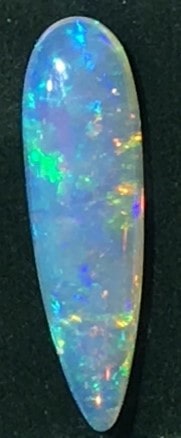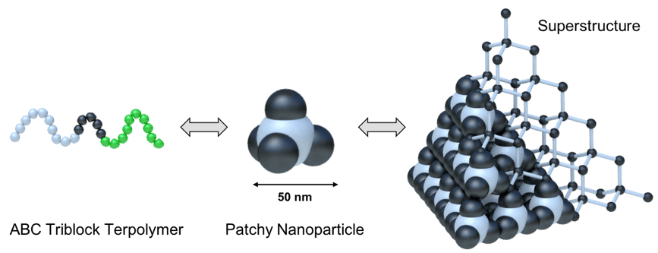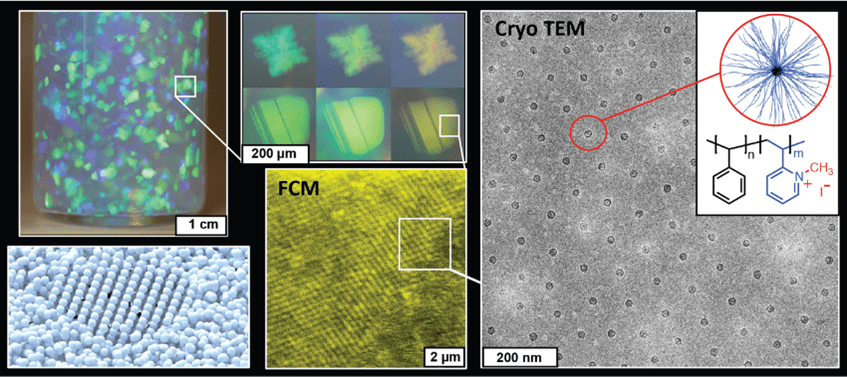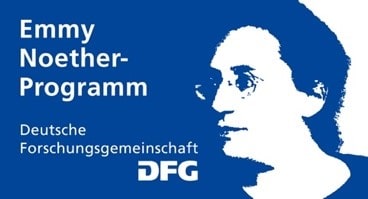Photonic Assemblies
Photonic Crystals

Opal. Natural photonic crystal of about 5 cm length worth 30 000$ (Cairns, Australia)
Photonic crystals are found in a myriad of examples in nature (sea shells, bird feathers, Pollia fruit), where the most instructive example might be opals. Opals are natural gemstones made of silica nanoparticles with diameter of 200-400 nm displaying bright and vivid colours (highly transparent gemstones are expensive; see photo of a 30000$ example from Cairns, Australia). Since structural colours are a result of the architecture, they never fade unlike, e.g., photo-bleaching of organic dyes (physical colour vs. chemical colour). Block copolymers recently demonstrated the ability to generate structural colours through ordered morphologies (usually lamella morphologies). To reach the required lattice parameters of 200-400 nm, either very large molecular weights are required to fill the space or special voluminous polymer architectures (e.g., polymer brushes). To compensate the relatively narrow window of refractive indices of polymers (typically n = 1.3-1.7), inorganic materials may be mineralized in polymer domains to enhance the optical contrast difference (brighter play of colours). In a DFG funded Emmy Noether project, we sought to bring together concepts of BCP synthesis, supramolecular self-assembly, and supracolloidal cluster formation to create open nanoparticle lattices with well-defined symmetry. The ultimate goal was to self-assemble a diamond lattice with photonic properties.
Programmable self-assembly of functional nanoparticle lattices

Self-assembly of ABC triblock terpolymer to patchy nanoparticles and crystallization into a diamond lattice.
The controlled self-assembly of nanoparticle lattices in the range of 50-500 nm remains challenging. There is a lack of nano-sized building blocks with low size-dispersity and high resolution of directional interaction patterns for the long-range ordering of nanoparticle lattices. To achieve these goals, we synthesized ABC triblock terpolymers with suitable compositions, which directly translate into the number of surface beads or patches. These patches are incompatible with the core and arrange in a geometric order. This order controls directionality of aggregation, potentially leading to nanoparticle lattices with symmetries reflecting those of the patch geometry.
First Photonic Liquids
In one of our works, we describe the assembly of BPCs to spherical micelles with super-stretched corona. The very narrow size-distribution qualified the micelles as building blocks for tuneable and reversible formation of photonic fluids and photonic crystals. The BCP micelles first showed slight bluish hues in concentrated gels (4wt.-%) with interparticle distances of around 150 nm as defined by electrosteric repulsion. Upon dilution (< 2wt.%), particle concentration is reduced, and fluids now consist of BCPs micelles with an average interparticle distance of 150−300 nm accompanied by a colour change to green and red. The increased particle mobility allowed for particle rearrangement and the formation of millimetre-sized free-floating photonic crystals with classical FCC lattice in the photonic fluid. These crystals are able to reflect surprisingly narrow wavelengths with FWHM as small as 1 nm. We expect this concept to open a facile way for self-assembled tuneable photonic structures. This work was done in collaboration with the Molecular Materials group of the Aalto University (Finland) and the Bio-inspired Photonics group in Cambridge (UK).

Text to figure: Photonic micelle crystals. Photograph flask with photonic crystals and two individual crystal types at varying angles. Fluorescence confocal microscopy image shows fcc lattice and cryo-TEM micelles in hexagonal packing.
Funding

